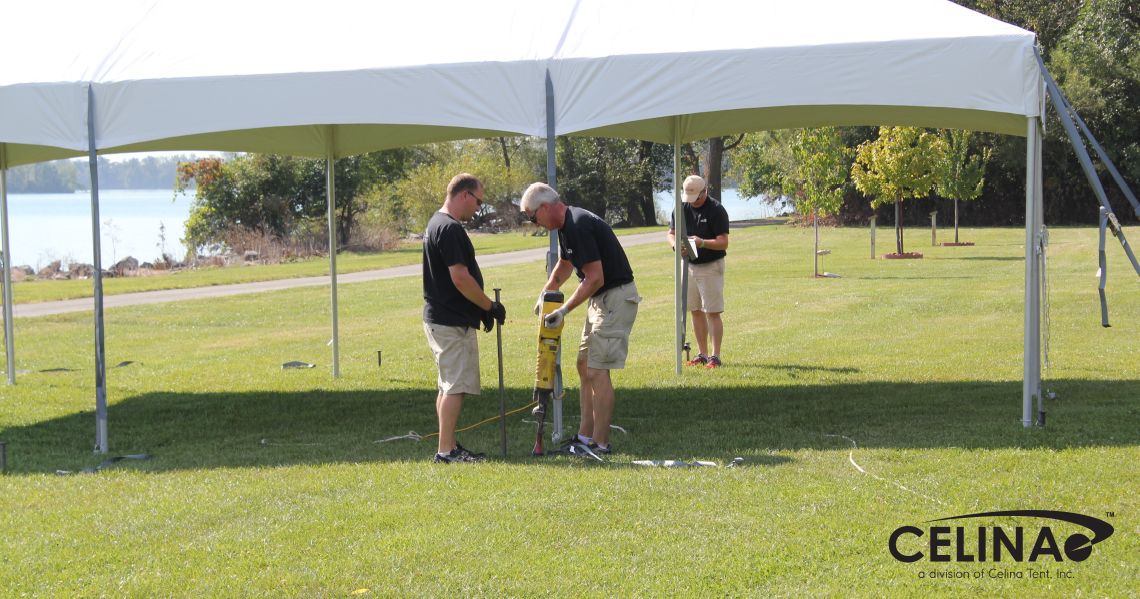Or, rather, “Suited for the Shelter: Canopy Anchoring” may be a better title. Suitable, even if it’s longer. But it’s done – nothing to do now but push on into the article. That’s how titles work.
Making sure a marquee installation is the safest it can be is the responsibility of the installer, but at Celina we try and give our customers and clients every possible advantage to make the most informed, safest choice they can when deciding how to go about preparing for an event.
This includes a few different practices on our behalf. Making sure our marquees begin with high-quality material and production methods ensures high quality end products that will last event after event. Providing a competent Knowledge Center on our website allows customers to access any and all information that pertains to marquee usage, care, and proper techniques to ensure that each event is weathered without so much as a broken finger nail*. It’s within this Knowledge Center that we have a page specific to the use of our primary staking nemesis – the water barrel.
The Weighty Issue
For the more uniformed, water barrels are a suggested method of canopy anchoring when a structure is installed on a surface where staking is difficult or undesirable. This applies mainly to frame supported structures. The thinking is that as a free-standing structure, a frame marquee only needs to be held in place in order to keep it in one spot (as opposed to pole structures, in which the tension placed on the poles and fabric by the anchoring are what keep the marquee lifted in the first place). This line of thinking can not only lead to damaged equipment but also bodily injury.
To begin with, the reason all marquees should be staked is that they have this nasty habit of catching wind, which can over large areas exert a lot of force. While it may not feel like much to you, even a light breeze spread out over the area of a 3 meter square frame marquee can start moving the structure. Acting like an enormous kite, frame canopies are easily scooted or even lifted entirely. A rolling ball of metal tubing and fittings is a scary sight.
Comparisons
A water barrel, normally holding about 55 gallons of liquid, does itself have a large amount of weight to it. The main problem lies with the attachment point – normally tied at the top of the barrel, this creates a situation where forces applied to the canopy can affect the barrel in the easiest way to move it, even full of water. The short length of guy line doesn’t allow for a large amount of hold. Tying a rope around the middle of the barrel, then around a marquee leg? This is even less secure since you’re running the attachment rope around the barrel and not directly connecting to the frame near the fabric, where the pull will be coming from.
Using stakes, even if you have to drill into cement, affords you the ability to increase the holding power of your guy lines immensely. Celina suggests the use of stakes (properly installed) because you can rely on their holding power with little variation or error introduced by the hardware – you can’t only half fill a stake with water, after all.
As seen in the security footage in this video, water barrel-secured marquees can take on a whole new life of their own. You just might not want them to (for a more extreme view of wind and canopies combining, watch our Severe Weather video). Just in case you’re still not convinced, you can give us a call at +44-115-794-0041 and chat with us at any time. Prefer communicating via text? We can be emailed at UK@CelinaTent.com or contacted through the chat window in the lower right corner of every Celina website. We look forward to chatting!
*Celina Tent Europe LTD is not responsible for broken nails
that may be accrued during the installation or striking of marquees, canopies,
or through attendance to any event where Celina fabric structures are installed
or used. Paying attention to the fingertips of guests and crews is solely within
the purview of the installers and event organizers.

(Tent) Anchors Away!